Located across the river from Amsterdam’s bustling city center, Amsterdam Noord was once an industrial area with little appeal to visitors. Over the past decade, this neighborhood has transformed into a thriving hub of sustainable development and circular economy practices. Here Metabolic and partners have revitalized polluted areas and demonstrated the scalability of our work. Our newest development, Sample, brings together the lessons learned and sets a blueprint for an innovative circular community.
Ten years ago, Amsterdam Noord was a relatively unknown area, overshadowed by the city’s more famous attractions. As an industrial zone supporting the port, it held little appeal for both tourists and locals who preferred the bustling city center.
Today, Amsterdam Noord has undergone a remarkable transformation. Residents and visitors now eagerly hop on ferries to cross the IJ River, drawn to this neighborhood for its lively mix of housing, offices, restaurants, studios, and museums.
Among the districts, Buiksloterham stands out as an inspiring example of circular and sustainable development. This designated circular living lab demonstrates how a once-polluted neighborhood can be transformed into a net carbon sink, embracing a circular resource model.
Metabolic has played a pivotal role in driving and scaling up the circular economy in Buiksloterham, collaborating with over 50 partners and stakeholders. Our projects have pushed the boundaries of circularity and raised the ambitions of similar initiatives. From repurposing recycled houseboats into a “cleantech playground” to developing a sustainable floating neighborhood, we have had the chance to pioneer circular innovation.
As we embark on our most significant circular development yet in the very same neighborhood, we find ourselves reflecting on the remarkable journey over the past 10 years.
How did an area once synonymous with factories and shipyards emerge as a thriving center of circular development? The answer lies in experimentation, collaboration, and the commitment to building a sustainable future — one block at a time.
De Ceuvel: A catalyst for reinvention
Our work in Amsterdam Noord began with De Ceuvel, a polluted site that seemed unfit for any meaningful use. Eva Gladek, CEO and founder of Metabolic, joined forces to build a cleantech playground that would regenerate the soil over the next decade.
At the core of Metabolic’s mission was the desire to go beyond conventional consulting and turn ideas and concepts into functioning models. This ambition led to our first iconic project, De Ceuvel, which serves as the foundational building block for much of our work. It laid the groundwork for sustainable development and set the stage for future endeavors, inspiring us to push the boundaries of circularity and pave the way for subsequent projects.

In 2013, Gladek and her early teammates scoured the Netherlands for reusable construction materials, collecting everything from wood to waterproofing supplies. It was a bit like Dumpster diving those days. They used these materials to construct the creative office park, where you’ll find studios for everyone from architects to writers, along with a sustainable community hub, aquaponics greenhouse, workspaces, hotel, and cafe.
(This was just the beginning of our work on urban mining, though fortunately, it has become more sophisticated over the years. We are now big proponents of materials passports, and we developed a method to harvest the metal in buildings.)
De Ceuvel was designed as a microcosm of resource flows. On the 1.2-acre zone, we transformed 17 old houseboats into buildings, cultivated specialized plants to clean the soil, and adopted low-cost clean technologies to ensure circular resource management. The project was full of experiments to test ideas for future circular developments.
Among the most successful experiments:
- Circular nutrient cycle: De Ceuvel served as a testing ground for innovative techniques, such as struvite reactors. This is a system to harvest struvite, a valuable fertilizer, from nutrient-rich wastewater, particularly urine. These nutrients are then used in the aquaponics greenhouse, instead of synthetic fertilizers.
- Phytoremediation: The project showcased a low-tech way of purifying polluted soil with plants, offering a sustainable solution for land remediation.
- Smart grid technologies: De Ceuvel’s experimentation with sharing and smart management of electricity, including the use of local blockchain energy currency called Jouliette, which was developed with Spectral, provided valuable insights into building resilient and efficient energy systems.
- Decentralized wastewater treatment: Research conducted at De Ceuvel explored decentralized sanitation approaches, contributing to the development of new forms of wastewater treatment that minimize environmental impact.
Insights from these experiments have been used by universities around the world, Waternet, and TKI programs (Top consortium for Knowledge and Innovation), contributing to the further development of these technologies.

Besides just the hands-on construction side, this project came with its fair share of challenges, from navigating financing and designing a sustainability plan from scratch, to addressing regulatory constraints.
“So many of the things that we were doing were not allowed by the city at the time,” Gladek said. “We were required to connect to the sewage system. We could not have a micro-grid system or a rainwater-to-drinking water upgrading system. But we wanted to test out these small-scale, sustainable alternatives. ”
Among Metabolic’s core values from the beginning: “Do epic sh*t.” So despite these obstacles, Metabolic and our partners continued to push the boundaries on what was allowed. With the city government’s cooperation, we demonstrated the benefits of this testing ground.

“The project is an example of Amsterdam’s commitment to urban experimentation,” the New York Times wrote in 2014.
Today, De Ceuvel is an internationally acclaimed circular economy case study. There have been more than 400 official tours, with visitors, students, and media traveling from around the world. You can even relax in a floating sauna, enjoy a plant-based dinner after a session, and sleep in a historic hotel boat.
“It’s a very hip and bustling place,” sustainability consultant Sam van Hooff told a group of students visiting from an American university. “Can you imagine, a former shipyard where you couldn’t even walk is now one of the most vibrant places in the city?”
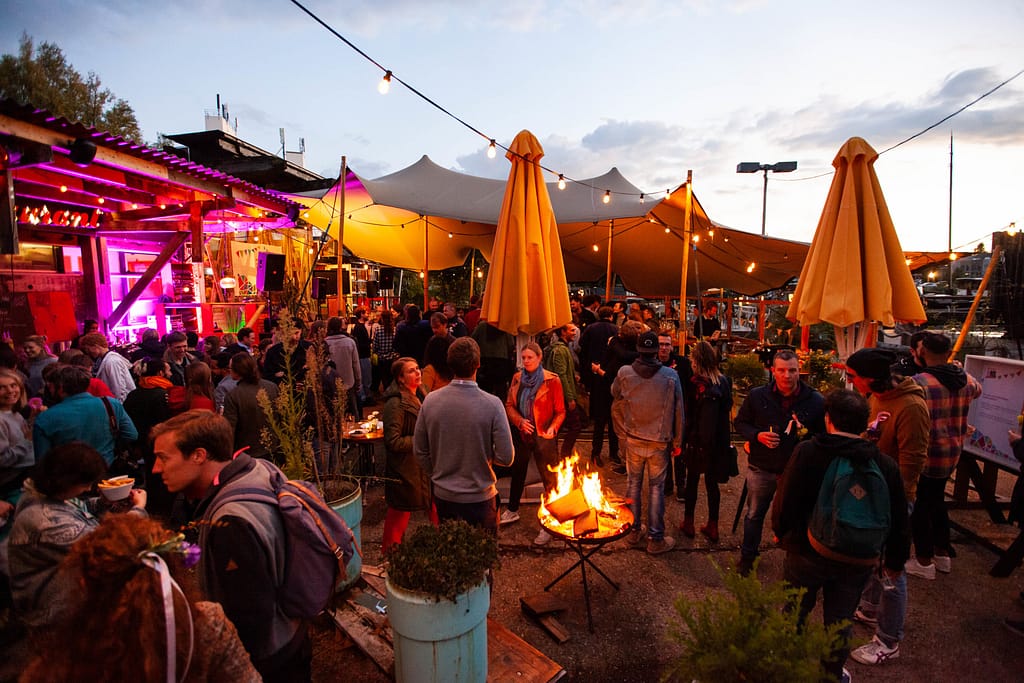
However, the city’s temporary lease for De Ceuvel expires in 2025, so the future is unclear. We are collaborating with our partners and the community to develop a bid for a new iteration of De Ceuvel.
“In the next phase of De Ceuvel, our aim is to establish a model for equitable and just development that respects the limits of our planet,” said Reinout Haisma, sustainability consultant in the Built Environment team. “We plan to do this by creating a truly participatory development process, by connecting with the neighborhood and building upon the community that has been developed and the innovative principles and knowledge gained over the past decade.”
A Circular Buiksloterham
De Ceuvel’s success paved the way for the transformation of Buiksloterham, a polluted post-industrial neighborhood spanning over 250 acres.
“This is where we started to see the intended ripple effect,” Gladek said.
Existing plans for the area already called for more than 8,000 new residences, so the challenge lay in maintaining the core of the neighborhood and preserving economic diversity.
Metabolic was engaged by a consortium led by the city of Amsterdam to develop a sustainability strategy and establish Buiksloterham as a circular living lab. We led a research and concepting team to shape a data-driven vision and action plan for what the area could look like with a circular model rather than business-as-usual. The resulting Circular Buiksloterham Manifesto encouraged development in the area to adhere to circular principles, leading to approximately 35 large-scale redevelopment projects with net zero carbon and circular material management ambitions.
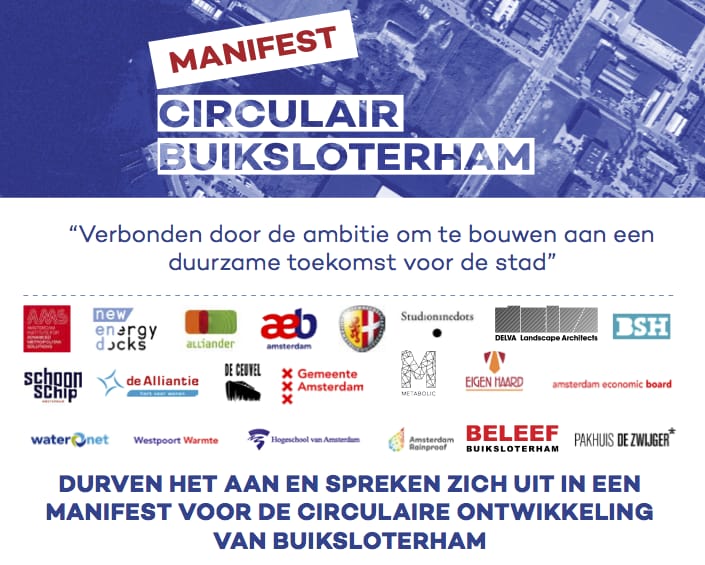
As a designated “circular living lab,” Buiksloterham became a hotbed of innovation and experimentation. The neighborhood attracted sustainability-minded individuals and businesses, fostering a creative and environmentally-conscious local economy.
“The sustainability ambitions of the dozens of projects realized in the area were unquestionably heightened as a result,” Gladek said.
Schoonschip: Europe’s most sustainable neighborhood
Buoyed by these successes, Metabolic continued to push the boundaries of sustainable development with its next project: Schoonschip. Made of 46 cutting-edge homes floating on the Johan van Hasseltkanaal, Schoonschip represented the next building block in our circular development journey.
“Schoonschip was like a De Ceuvel 2.0,” Gladek said. “Imagine you have the same principles as De Ceuvel, but you actually have a proper budget and resources to take that to the next level. And that’s what we did.”
Schoonschip, meaning “clean ship” in Dutch, was a community-driven initiative that aimed to design and build energy-neutral households on a canal in Amsterdam Noord. Each house was designed to be energy efficient, with features such as solar panels, heat pumps, and rainwater harvesting systems. Furthermore, the entire neighborhood was interconnected to form a smart energy grid, enabling residents to share excess energy and reduce their collective carbon footprint.
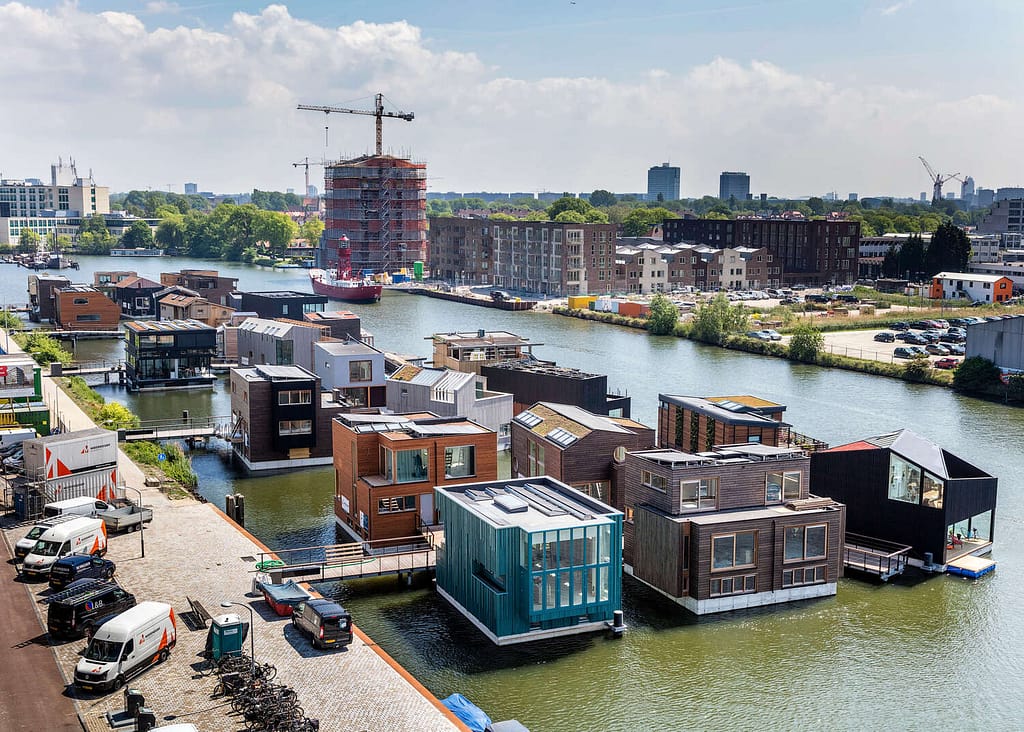
As part of the building and design team for Schoonschip, Metabolic’s work became much more sophisticated. For instance, we modeled light patterns and how the buildings could optimize heat capture. We also created a manual detailing the systems and processes that architects could use in the design of the homes, along with a materials guidebook.
“Schoonschip, boasting modern design for modern lifestyles, seeks to serve as a prototype for the more than 600 million people — 10 percent of the world’s population — who live on or near the water and are already being affected by climate change,” reported the Washington Post.
From Amsterdam and beyond: Systemic change
Amsterdam’s position as a global frontrunner in the circular economy has propelled us to extend our impact beyond the boundaries of Buiksloterham. As we envision a future city that harmoniously connects our planet, communities, and resources, we recognize that cities and the built environment hold immense potential for driving systemic change. “Cities occupy just 3% of the earth’s land surface, but are home to more than half of the world’s population,” we wrote in our vision. “They are engines of the global economy, but many are trapped in an operating system that harms the health of people, other species, and the planet.”
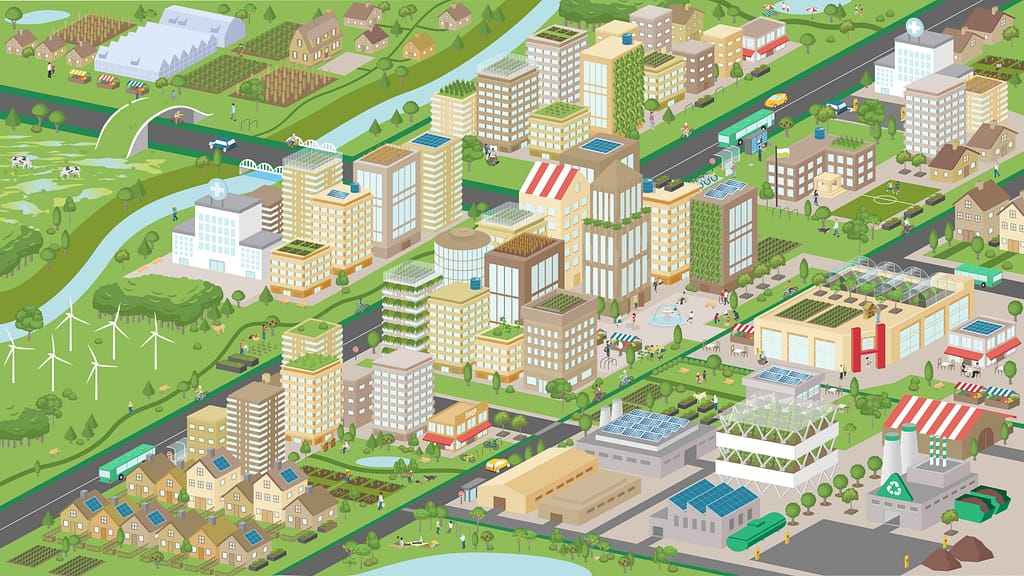
Partnering with pioneering organizations and advocating for pilot projects and policies that foster circular development has been instrumental in Amsterdam’s success. Over the years, we have partnered with the city on its circular journey. Our initial focus was on studying resource flows and urban mining, which then culminated in the development of circular construction tendering guidelines. These guidelines have empowered the city to adopt our circular thinking and apply it to other locations. Amsterdam was a frontrunner to allow a site like De Ceuvel to take shape and showing how pilot projects can turn into policies.
Scaling up our efforts has been a key aspect of our approach. By conducting larger-scale regional circular scans and working across various levels, we have uncovered the cascading logic that underpins the circular transition. This approach has enabled us to analyze the impact of scaling from individual buildings to neighborhoods, cities, and regions.
For instance, we have also helped other provinces transition towards a circular economy, including the northern region of Friesland.
Collaborations fuel successful impact
Along the way, we’re constantly reminded of the importance of partnerships. Our focus on the built environment now extends throughout the entire Netherlands. Collaborating with Circle Economy, C-creators, Copper8, NIBE, and Alba Concepts, we conducted a comprehensive assessment, resulting in the Circularity Gap Report – Built Environment, the Netherlands. This report highlighted the construction sector’s resource consumption and proposed scenarios to achieve the sector’s circularity target by 2050.
Taking our work even further, we delved into the pressing issue of the construction sector’s carbon budget, which is projected to be depleted by 2027 if no interventions are made. By studying the material demand, CO2 emissions, and environmental impact of planned housing, we identified strategies to reduce this impact.
“After 10 years of doing this work, we know that we can amplify our impact by partnering with like-minded organizations,” said Gerard Roemers, director of our Sustainable Cities & Regions team. “The circular economy is about collaborating and creating strong bonds which can help create a new economy.”
While European cities have taken strides in embracing circularity, cities in the United States are beginning to take notice. We helped Charlotte, North Carolina explore how to become the first circular city in the country, focusing on the first De Ceuvel-like innovation project stateside. The Innovation Barn is a living lab for the circular economy, allowing local loops to be closed and visitors to experience what a circular future looks like. In Cleveland, Ohio, we helped kickstart the transition to an inclusive circular economy.

“Drawing on experience from other circular cities worldwide allows us to build on existing knowledge to create the greatest impact in terms of resilience, health, and local green jobs,” said Andrew McCue, one of our circular economy experts.
In line with our commitment to collective action, we have formed the Circular City Coalition in collaboration with four organizations that share our vision. Together with PXYERA Global, Enel North America, Rheaply, and First Mile, we are laying the foundation for a circular economy, leveraging a new circular innovation ecosystem fund to drive progress.
From Amsterdam to Charlotte, we are continuously learning about a sustainable built environment, and experimenting with what is possible. This knowledge, accumulated block by block, serves as the foundation for our work.
“We try to bring the lessons learned from our partners and clients all over the world back to our hometown of Amsterdam,” said Mink Rohmer, a data analyst on Metabolic’s Built Environment team.
Sample: A blueprint for a circular community
After 10 years of working in Buiksloterham and on circular design, we are embarking on our most ambitious development project yet: Sample. (This time though, we won’t be Dumpster diving for construction materials.)
Sample, located just meters down the canal from De Ceuvel, represents the culmination of Metabolic’s first decade of work in the built environment. It brings us full circle from our pilot, De Ceuvel, marrying the learnings from various projects and serving as a blueprint for building a circular society. The 48,000-square-meter circular mixed-use development demonstrates that through experimental projects, building relationships, and hands-on work, we can successfully scale our impact.
“It all comes together here,” said Nico Schouten, our green building expert who leads Metabolic’s built environment consulting team. “After 10 years, we return to Buiksloterham to bring all our knowledge back to an applied project. What is beautiful about Sample is that it combines the best features from our earlier projects plus everything we have learned over the past decade into a new project which, hopefully, will inspire designers, policymakers, construction companies, and everyday people.”

The name “Sample” refers to the term used in hip-hop, where existing musical elements are combined into new music. So just like in music, this project is about sharing, reusing, and recreating, in both the design and the intended use.
Acting as the sustainability stewards, we joined an impressive list of partners to design Sample, including KondorWessels Vastgoed, Verdedig Noord, Space&Matter, Mecanoo, ZUS, Finch Buildings, TRAJECT Adviseurs & Managers, Arup, and Sweco. Sustainability represented a significant portion of the city’s requirements for the tender; winning the tender demonstrates our team’s credibility and validates the ecosystem approach.
Sample aims to make circularity accessible for everyone. The project combines free market owner-occupied homes, medium-priced and social rentals, a Circular City Hub, workspaces, an urban farm, gardens, and common spaces. The design prioritizes reusable materials, natural resources, and climate adaptability.
“What we did with De Ceuvel — integrate use phase, energy, water, inhabitants, and tendering guidelines, into one system — we will do it again but now 10 times bigger,” Schouten said.
For instance, our team has come a long way from driving a van across the country and hunting for reusable construction materials. After Metabolic built and advised on urban mining models for years, now, there are companies completely focused on urban mining, inspiring the construction sector that this is feasible.
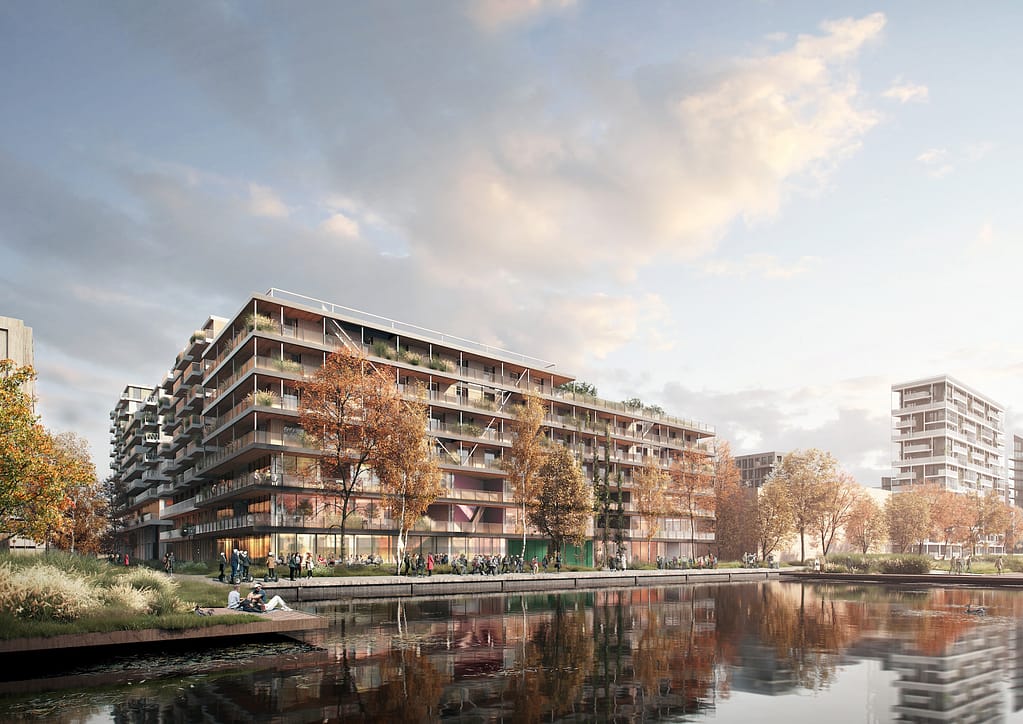
About 80 percent of the buildings will be made of either bio-based or reused materials, an extraordinarily high percentage for a project of this scale. The buildings are climate adaptive, with facades that conform to the season. Human-free zones will allow biodiversity to thrive. The project has been designed with “original Northerlings,” or people who already live in the area, to create a neighborhood that is affordable.
Sample represents a significant leap in scale for circularity both inside and outside Buiksloterham. The project focuses on scaling up existing innovations while also training the notoriously conservative construction sector to adopt new ways of working. It serves as a learning construction site and an educational center that will continue to provide resources for the sector long after its completion.
The development of Sample goes beyond the physical aspects of circularity and considers the social dimension as well. It seeks to make circularity accessible, valuable, and tangible for everyone, addressing the gap created by eco-gentrification.
And for the team at Metabolic, Sample is an exciting project because it will be the site of our future office. We’ll join our friends Space&Matter and Spectral at the Circular City Hub: a place where circular initiatives, hospitality entrepreneurs, and knowledge institutions converge to contribute to the leap in circular scale.
Looking to the future
Sample represents the next building block in Metabolic’s vision for circular cities and a sustainable future. We like to envision that we are stacking the building blocks to form a solid structure of sustainability. A collaborative approach ensures that as our projects scale up, the transformation of the community becomes more tangible. The collective power of these building blocks becomes evident, driving the creation of a sustainable and thriving neighborhood.
Sample is both a milestone in our journey towards a circular built environment and a celebration of collaboration and knowledge sharing. As we continue to push the boundaries of circularity, Sample serves as an inspiration and catalyst for future projects. It showcases the possibilities and potential of a circular future, where cities are designed to be regenerative, inclusive, and prosperous.
Read more about our work on the circular built environment:
Schoonschip: A sustainable floating neighborhood
Prospecting the Urban Mines of Amsterdam
Circular Buiksloterham
City of Amsterdam: Circular building tendering for sustainable innovation
Circular Amsterdam: Spatial analysis for effective city planning
Monitoring circularity in the Metropolitan Region of Amsterdam